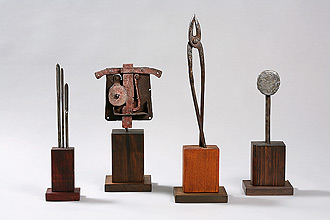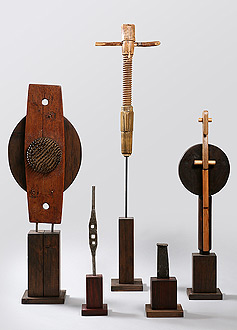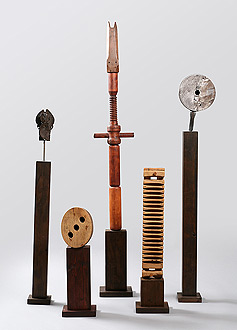Skulpturen / Skulptures - Poetry of Things - to the objects of Rolf Hans
 4 Röhren - Versuche I/4, 1972
4 Röhren - Versuche I/4, 1972
At the beginning of the 1970s, Rolf Hans first dealt with the design of objects. They are small sculptures made of iron pipes with a round or square profile. With them, he seeks to create a new, three-dimensional reality of experience in parallel to his paintings, which are created at the same time. However, Hans also experiments with the connection between object and painting and combines both in a work such as „4 Röhren Experimente I / 4", 1972. In addition, in the middle of the decade he also produces a number of figurative sculptures made of various materials, such as the " Maske(75) ", which he composed of wood and plastic. But he does not follow this path at first:" In the midst of the work on the poetry I discover two works, created in 1972 and 1975, quite a friend of the issues at that time, and therefore not continued. But in the poetry of things they fit, as if they were made for them, as long as a work is fermenting.“
In 1987, Hans resumes the medium of sculpture. In the phase, the working process is no longer considered to be a deliberate constructing, but to be guided by the given. And as with his painterly work, his objects now emerge out of an inner necessity, not to fill an intellectual vacuum. "This compulsion has kept me under control for decades, and for a few years I've been trying to pacify it with the cycle of 'poetry of things'. Such satisfaction of constraints existed in the past as the results of pictures, drawings and graphics were very sparse. Whenever and however the idea for the cycle arose, my knowledge eludes me. Sure, there were things that made it worthy to be put on a 'pedestal', the two early works testify to it. At some point in 1987, the work on the poetry replaced another, which forced itself to conclude. Slowly, very slowly at the beginning, with many dubious attempts, the eye was trained for the new task. The spiritual climate was prepared „.
So Hans concentrates in his last decade of life on the work on the sculpture cycle. And as if in intoxication, he draws on the newly given possibilities afforded him by the creation of objects: "The poetry of things grows, it swallows all time, much is neglected, hardly any letters, the diary is largely silent, concerts are limited to essentials , It creates a compulsion and yet started as a game, but attempts were always a serious thing that demand the whole guy. [...] The objects have sneaked into my Ratio, carefully and unnoticed, take their place, have taken him, are part of myself. „
Rolf Hans gets stimulated by the art of other cultures, for example, the Africa, New Guinea, China, the Indians or the ancient Germans, which he in collections u. a. in Basel, Berlin or Paris. He is particularly impressed by the diversity of the tribal art of primitive peoples, he notes to an African mask: "A white face, strong nose, a pouty mouth and children's eyes, I could not resist buying the mask. She is tall and heavy with a memorial on her forehead. Certainly not old, certainly not valuable, she looks lovely, not terrifying. Now she's hanging on the bookshelf, enjoying my eyes every day. „
Of course there are also inspirations from Hans's own culture for Hans. Here he enumerates the "ready-mades" by Marcel Duchamp and the abstract-styled forms of the sculptures by Constantin Brancusi as well as the poetic dream associations and ironic-bizarre themes of Paul Klee. But also the "objet trouvé" by Max Ernst may have inspired him to his sculptures. In addition, he certainly also receives impulses from the witty bizarre machines of Jean Tinguely and from the iron sculptures by Bernhard Luginbühl. Both artists got to know Hans personally in the 1960s and have followed their artistic development ever since.
 Marcel Duchamp, Roue de bicyclette, 1913/14
Marcel Duchamp, Roue de bicyclette, 1913/14Fahrrad, Holzhocker, nummerierte Auflage
 Max Ernst, D 1971, 1971,
Max Ernst, D 1971, 1971, Collage aus Holzbrettern auf Holzplatte montiert,
Max Ernst Museum, Brühl
It's a difficult thing to do with art, looking at its predecessors, trying to find its way, the zeitgeist and its aesthetics are influencing the direction, you know if you're feeling dissatisfied. Now in the midst of the 'poetry of things' a sense of being free, yet intimately connected with much that was before, work without any compulsion, there is no program, just a title that allows any work of freedom. "But despite the role models From the beginning, Hans succeeds from the very beginning in finding his own formulation possibilities with his object cycle. What unites him with Max Ernst and his Swiss artist colleagues is only the source material: lost property.
He discovers these most different and unnoticed things mainly in wood and metal at flea markets, at junk-good dealers, in barns, cellars and stables, or in antique shops. He repeatedly encounters incomprehension of his fellow human beings and adversities, as he must learn during a visit to an antiquarian bookshop in Amsterdam: "through the shop window, in the dark on the wall a tool used for the processing of flax, an object for fetish No.? However, the price exceeded the budget of the poetry of things. In addition, the antiquarian had no understanding of my idea to process their antique to an object, you satisfied the object as an antique, especially since it was Dutch engraved with year. After explaining my way of seeing, her way of perception, she became accessible, gave me addresses, and so I found some objects for the poetry of things in Amsterdam. "He also finds useful things in his friends 'and acquaintances' workings for the processing of his objects on: "Daniel is rebuilding his bachelor house [...]. I asked for the wooden railings of the gallery, they must give way to a concrete floor. Hope he does not burn it for lack of space, before I organized a transport opportunity. „
The things thus found are largely from the near or distant past. Among them are quite unusual objects, such as: flat tears, conveyor belt wheels, hoes, Hutformer, ox yokes (see "Fruchtbarkeit I", Fig. 87), wine barrel lid, ‚Wetzsteinbehälter‘ , cigar dryer (see "Canto I" and "Figure XVI" Fig. P. 87) and spindles. The list could be extended many times over. These are very commonplace things of everyday life - formerly necessary, useful and practical such as tools, utensils, devices - which have been deprived of their function and now serve the artist as a door to fantasy: under his hands, with only a few means, he becomes one on a pedestal assembled locksmith a delicate "Tänzer", 1987, who wants to show us a pirouette; or from a split wedge made of ones hammered into the block of wood, the "Blume III", shimmering in the light, 1987. Looking more closely at the former splitting tool, we can see that the metal driven by heavy use hangs like withered leaves at the edges of the striking surface. And there, from an iron lock welded onto a pole, are the "Gesichter VII", 1992, which mischievously greet us.
In this way, Hans strips things of their previous, traditional function or their archaic purpose and transports them into another, new reality in order to resurrect them. At the same time he does not want to deny the found figure without aesthetizing. Changing its 'innate' structure, traces of use and color only slightly, it seeks to emphasize its purpose as a form and to redefine its inherent aura. "This representation of the purpose / content as form [is] a visual process influenced by the past, without direct recourse." Nevertheless, he wants to create new forms through the removal or by adding strangers, whereby he does not consider the editing process as a reality. Invention, but sees as a reality experience. In this procedure, what he finds always prescribes the creative process. However, he sees this influence not as an obstacle, but as a way of freedom to subordinate the nature of things to the laws of art. So he uses the ability of art to sublimate things. "What is special about Rolf Hans is that he does not seem to be able to design his works indiscriminately, but conveys new content values with his artisthood. The objets are processed, have to discover their character in the struggle with the artist and to make new statements in connection with other objects. „
Without any artificiality Hans presents the abstract symmetries of wood and metal objects and places them on a pedestal, obeying the artistic tradition. He also integrates this into the work. For as the lowest component, the pedestal not only prepares for the sculpture, but loosens, loosens or consolidates its earthiness. With this raising, he gives the sculptures another life of their own, a kind of second existence, so to speak, and gives them a new identity with a new name. "They show their personality, one more, another less, as it is in life, or in art." What they all have in common is their work from the past into the here and now. In doing so, they reveal their original beauty and the mystique that inspires our imagination.
The mystery that emanates from the objects also comes into play in the titles. Without referring to their original function, Hans usually selects names from the cultic field, such as "fetish", "oracle", "runes", "stele" or "totem". Or he refers to the culture of Africa, such as "Afrikanisches", „Afrikanischer König", "Maske" and „Waningo".
One might think that the term "Canto" - vocals - belong in this area. But here Hans draws on the idea of the eponymous work of the American writer Ezra Pound, created between 1915 and 1962, in which memories, impressions of the moment, and quotations are combined with time criticism without any logical connections.
 Gesichter VII, 1992
Gesichter VII, 1992



 Kopf XI, 1992
Kopf XI, 1992
For the names "Ubo" and "Madame Ubo", 1988, Hans is animated by Alfred Jarry's fantastic as well as grotesque play "King Ubu", which premiered in France in 1896. The grim-comic drama with its excessive feces treats the equally cruel and avaricious and cowardly father Ubu: Motivated by his devious wife - mother Ubo - he kills the king by means of a conspiracy in order to take his place himself. However, he is overthrown and must finally flee on a ship. Here, qualities - such as stinginess, violence, stupidity and self-indulgence - are displayed in a parabola, which are often hidden behind the „biedermännischen Fassade“ . Taking up the main characters of satire, Hans subtly and humorously incorporated critical remarks into his „Poesie der Dinge", as the sculpture „Kopf eines typischen Mitgliedes unserer Gesellschaft" from 1987 points out.
In Rolf Hans' fantasy world we find cheerful and serene, sometimes serious and scary things and 'actors'. They surprise us with their idiosyncratic beauty, whose magic we can not escape. They always bring astonishment and reveal the ambivalence of an object.
There we meet the "figure XVI", born of a big trap, two cigar dryers and a wooden wheel, in 1994. Terrifying, she looks at us, and her big round belly gives us an idea of what she is looking for.
As we come suddenly to death, as in the wooden figure of the same name from 1992 ("Tod I", Fig. P. 89), which consists of a headboard, a thread and a wheel divided by a middle of a styling board. It does not put us in fear. Rather, she mediates peace, because her whitewashed face with closed eyes and mouth exudes conciousness and peace of mind despite the violence.
On the other hand, the head of the "Krieger III", 1988, - a large, partly rusty gate lock - irritates us: despite the big wound on his right cheek, he grins at us with a big smile. If you did not know the title, we could think of a make-up clown's face.
Likewise, the "Kopf XI", 1992 - a base-mounted tin pot (a bed warmer?) - appears to be injured. If you move your left 'face half' aside, you can look into it. In this way, with a wink, does he fulfill the often-cherished wish of being allowed to look behind our counterpart's forehead? But what we find in his heart is disappointing: darkness and emptiness.
By whatever ambivalent way the sculptures and objects of Rolf Hans meet us, they never do this loudly or exalted. In their balanced and simple appearance, they quietly enter into contact with us. Outlandish, they keep asking us to ask questions: who am I? Where do I come from? Where am I going? They offer us no clues that could help us in the answer. For this they give us the greater scope for associations and imaginations. They appeal to our subconscious. They invite us to linger and to meditate: It is the familiar beginning and the unconscious departure to the secrets of creation.